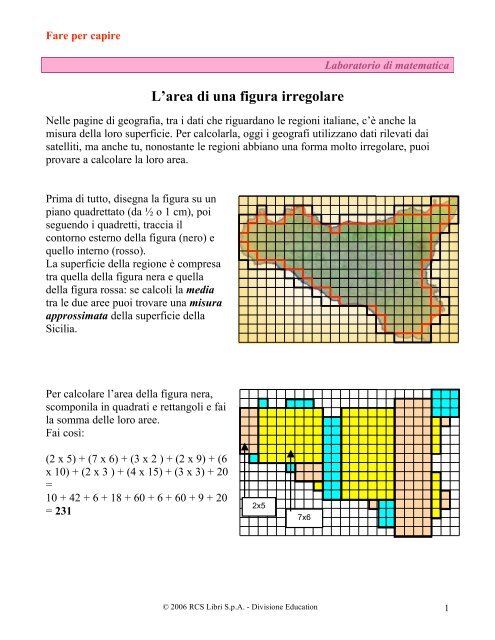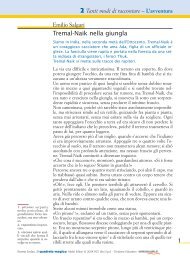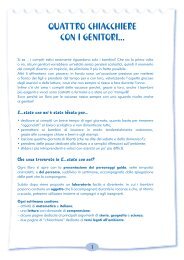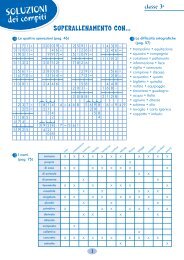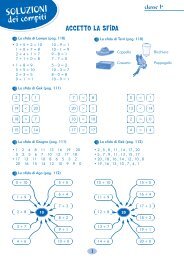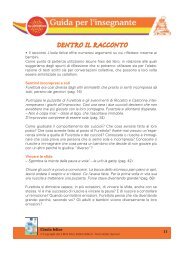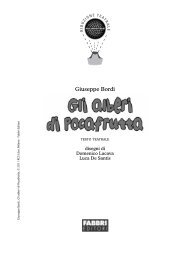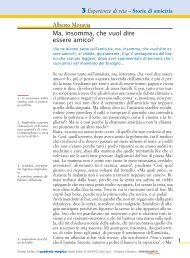L'area di una figura irregolare
L'area di una figura irregolare
L'area di una figura irregolare
Create successful ePaper yourself
Turn your PDF publications into a flip-book with our unique Google optimized e-Paper software.
Fare per capire<br />
L’area <strong>di</strong> <strong>una</strong> <strong>figura</strong> <strong>irregolare</strong><br />
Laboratorio <strong>di</strong> matematica<br />
Nelle pagine <strong>di</strong> geografia, tra i dati che riguardano le regioni italiane, c’è anche la<br />
misura della loro superficie. Per calcolarla, oggi i geografi utilizzano dati rilevati dai<br />
satelliti, ma anche tu, nonostante le regioni abbiano <strong>una</strong> forma molto <strong>irregolare</strong>, puoi<br />
provare a calcolare la loro area.<br />
Prima <strong>di</strong> tutto, <strong>di</strong>segna la <strong>figura</strong> su un<br />
piano quadrettato (da ½ o 1 cm), poi<br />
seguendo i quadretti, traccia il<br />
contorno esterno della <strong>figura</strong> (nero) e<br />
quello interno (rosso).<br />
La superficie della regione è compresa<br />
tra quella della <strong>figura</strong> nera e quella<br />
della <strong>figura</strong> rossa: se calcoli la me<strong>di</strong>a<br />
tra le due aree puoi trovare <strong>una</strong> misura<br />
approssimata della superficie della<br />
Sicilia.<br />
Per calcolare l’area della <strong>figura</strong> nera,<br />
scomponila in quadrati e rettangoli e fai<br />
la somma delle loro aree.<br />
Fai così:<br />
(2 x 5) + (7 x 6) + (3 x 2 ) + (2 x 9) + (6<br />
x 10) + (2 x 3 ) + (4 x 15) + (3 x 3) + 20<br />
=<br />
10 + 42 + 6 + 18 + 60 + 6 + 60 + 9 + 20<br />
= 231<br />
2x5<br />
7x6<br />
© 2006 RCS Libri S.p.A. - Divisione Education 1
Fare per capire<br />
Fai lo stesso con la <strong>figura</strong> rossa:<br />
(9 x 3) + (3 x 2) + (3 x 4) + (6 x 9) + (4 x<br />
5 ) + (3 x 8) + (2 x 2) + 23 =<br />
27 + 6 + 12 + 54 + 20 + 24 + 4 + 23 =<br />
170<br />
Ora calcola l’area me<strong>di</strong>a tra le due figure facendo questo calcolo:<br />
(A <strong>figura</strong> rossa + A <strong>figura</strong> nera) : 2 =<br />
(231 + 170) : 2 = 200 quadretti circa<br />
Il risultato che ottieni è un numero <strong>di</strong> quadretti: se vuoi scoprire la misura reale, devi<br />
moltiplicare questo numero per l’area <strong>di</strong> un quadretto nella realtà (ricorda però che il tuo<br />
<strong>di</strong>segno è ridotto in scala!).<br />
Ad esempio in questo <strong>di</strong>segno 1 quadretto equivale a 130 km 2 quin<strong>di</strong> devi fare questo<br />
calcolo:<br />
Area me<strong>di</strong>a x 130 = 200 x 130 = 26 000 km 2<br />
Confronta il tuo risultato con la misura che trovi nel libro <strong>di</strong> geografia.<br />
È molto <strong>di</strong>fferente?<br />
9x3<br />
3x2<br />
© 2006 RCS Libri S.p.A. - Divisione Education 2


